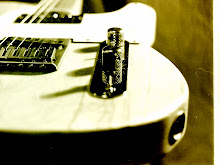
The desert guitar poets of Tinariwen at The Paradise , 11/18/11.
It was desert a go-go at The Paradise Rock Club in Boston last Friday night as the core of the Tuareg musical collective known as Tinariwen graced the stage with their simple, compelling guitar riffs (acoustic and electric), nomadic rhythms and rich vocal harmonies.
Think Led Zep’s “When the Levee Breaks” coupled with CSN’s soaring harmonies, and James Jamerson’s boisterously funky bass playing. Spread on some sweetly sung, albeit indecipherable, lead vocals – occasionally French, but mostly some Tuareg tribal dialect – and weave it around North African drumming and slinky, quite Western-friendly guitar riffs and you’ll begin to have an idea of the sound these serious soul men brought to town.
What a vibe! It was an inspiring evening of music – and one of those occasions that really makes me appreciate being in Boston with the opportunity to see (and hear!) a rare performance such as this. Even after all these years, I never take these kinds of things for granted. And they’re all the better experienced in a familiar old favorite like the (legendary) Paradise, where you can easily get a clear view of the action from 15 away or less – and still be no more than twice that distance from the bar! Paradise, indeed.
Playing as a quintet for most of the evening, the desert-dwelling dudes were all decked out in turbans, with the exception of founding member Ibrahim Ag Alhabib, the frizzy-haired face of the band who, in an old blues bandleader-like star turn, let his compadres warm up the crowd for a bit before making his appearance.
Fortunately, he wasn’t even missed, so good was his stand-in, young bandleader-in-the-making Hassan Ag Touhami, a fine singer and riffmeister on both acoustic and electric guitars. He spelled Ibrahim for the first half-dozen or so songs and again for several songs early in the encore. The band brought the celebration to a joyous close with all six members on stage, at which point Hassan again relinquished center stage to the elder Ibrahim, and joined in on backing vocals and dancing duties. The aforementioned bass playing of Eyadou Ag Leche was also exceptional and noteworthy in the superbly simple but sophisticated sound.
If you have the least bit of interest in blues-like world music, I highly recommend you check out Tinariwen – at the very least on record and, by all means, if you have the opportunity, in concert, too.
Further:
• Some fine listening ... All the collective’s releases are worthwhile, but you'd do well to start with:
– their latest, 2011’s Tassili (more acoustic and definitely more Westernized than their previous releases),
– 2001’s The Radio Tisdas Sessions (produced by English guitarist and world music afficianado Justin Adams of Robert Plant’s Strange Sensation band), and
– 2009’s Imidiwan (more electric like North Africa meets Memphis blues).
• Learn more about Tinariwen’s background.







